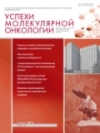STUDY OF THE RELATIONSHIP BETWEEN CIRCADIAN RHYTHMS AND DRUG RESISTANCE OF BREAST TUMOR CELL LINES
- Authors: Оgloblina A.M.1, Rybalkina E.Y.1, Кirsanov K.I.1, Moiseeva N.I.1, Кondratov R.V.2, Susova O.Y.1
-
Affiliations:
- Research Institute of Carcinogenesis, N.N. Blokhin Russian Cancer Research Center, Ministry of Health of Russia, Moscow
- Cleveland State University, Cleveland
- Issue: Vol 2, No 3 (2015)
- Pages: 60-62
- Section: RESEARCH ARTICLES
- Published: 18.12.2015
- URL: https://umo.abvpress.ru/jour/article/view/46
- DOI: https://doi.org/10.17650/2313-805X.2015.2.3.60-62
- ID: 46
Cite item
Full Text
Abstract
About the authors
A. M. Оgloblina
Research Institute of Carcinogenesis, N.N. Blokhin Russian Cancer Research Center, Ministry of Health of Russia, Moscow
Email: susovaolga@gmail.com
Russian Federation
E. Yu. Rybalkina
Research Institute of Carcinogenesis, N.N. Blokhin Russian Cancer Research Center, Ministry of Health of Russia, Moscow
Email: susovaolga@gmail.com
Russian Federation
K. I. Кirsanov
Research Institute of Carcinogenesis, N.N. Blokhin Russian Cancer Research Center, Ministry of Health of Russia, Moscow
Email: susovaolga@gmail.com
Russian Federation
N. I. Moiseeva
Research Institute of Carcinogenesis, N.N. Blokhin Russian Cancer Research Center, Ministry of Health of Russia, Moscow
Email: susovaolga@gmail.com
Russian Federation
R. V. Кondratov
Cleveland State University, Cleveland
Email: susovaolga@gmail.com
United States
O. Yu. Susova
Research Institute of Carcinogenesis, N.N. Blokhin Russian Cancer Research Center, Ministry of Health of Russia, Moscow
Author for correspondence.
Email: susovaolga@gmail.com
Сусова Ольга Юрьевна Russian Federation
References
Supplementary files






